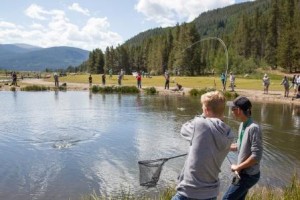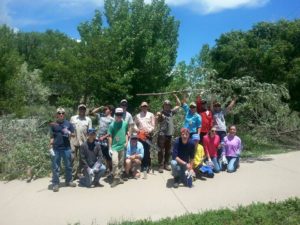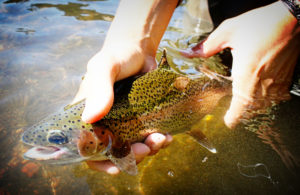Heather holds a nice South Platte River rainbow.
Photo Courtesy of Brandon Miller
Colorado Trout Unlimited’s The Greenbacks have a new president. Founder of The Greenbacks Nick Hoover has recently handed the position of president off to Heather Sees. Heather is a dedicated fly fisher, employee, volunteer and steward of the land. Her passion for protecting and conserving wild, native spaces falls right in line with The Greenback’s original goals and has allowed her to make a few of her own. Her ability to articulate the needs of a community allow her to cast a wide net over a diverse group of peoples; this combined with her dedication to involving disenfranchised youth in the outdoors ensure The Greenbacks will not feel the growing pains that usually come with leadership change. Heather’s no bull all straight talk leadership style combined with her community based approach to relationships make her the perfect fit for the job.
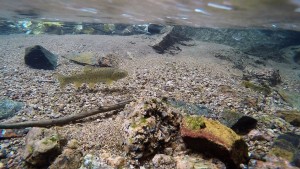
Before Heather was president of The Greenbacks I knew her through time spent on the river. She is a fishing machine to say the least. We spent a day on the frying pan together fishing the toilet bowl and I remember her catching far more fish than me and loosing far less flies. Unlike most fisherman, she is humble, willing to hear all side of an issue and does not fall prey to fallacious arguments. To get to know Heather better as a professional and a leader I was able to ask her some questions about her new found responsibilities.
Why are native trout important to you?
“The Greenbacks are important to me because they represent one of the most diverse trout species in North America. When it was determined that the “pure” strain of Greenbacks was on the verge of extinction I knew that I needed to get involved because I believe it’s important to protect a fish that plays an important role in Colorado’s ecosystem and natural heritage” Heather Sees, President of The Greenbacks.

Why did you take the job as president of The Greenbacks?
“I took this role because I looked at it as a great opportunity to challenge myself personally and challenge those folks who are involved with the Greenbacks. This role also presents an opportunity to build on the strong foundation that we have and expand our role within the fly fishing community and CTU organization.”
What is the keystone character trait in a leader? How do you hope to exemplify that trait in your own leadership?
“For me a key trait is integrity/consistency along with being very self-aware. I am a strong believer that a great leader must lead by example and is consistent in their actions. I consider myself to be one of the most honest (almost to a fault) folks that you will meet. I am also very self-aware – I am tuned into my own limitations and know where I thrive and where I have challenges. Knowing this, I tap into the other Greenbacks members for support so that as a whole we are successful in our mission.”
What are your short term goals for The Greenbacks?
“As of right now the short term goals are to educate folks on the state of the native greenback here in Colorado, engage and recruit new volunteers/members along with partnering with the local Colorado Trout Unlimited chapters on their projects.”
What are your long term goals for The Greenbacks?
“Long term we have plans to champion a big greenbacks recovery project where we can plug in our strong volunteer base. We will also continue to strengthen our youth education program by engaging the local college fly fishing clubs, high school clubs and youth organizations (i.e. BBBS, Girls, Inc, etc).”
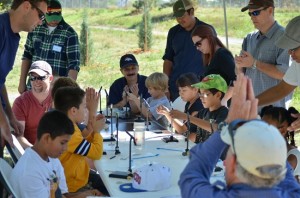
Heather has a lot of work to do. Organizing a group of volunteers to complete what may seem like an unattainable goal, requires dedication and perseverance. Heather embodies both of these traits. These traits do not define her though. She fishes often in her free time and enjoys the social aspect of The Greenbacks. Her passion for the outdoors runs deep. She exudes stewardship and genuinely cares about the health of ecosystems. Thank you Heather for striving to make Colorado a more native place.
If you would like to get involved with The Greenbacks check out their website for awesome fly tying events, volunteer projects, and monthly meetings.






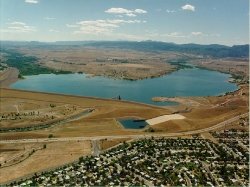 It was
It was 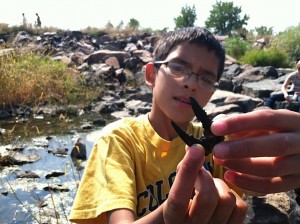 Projects like Stream Explorers have also helped the South Platte by teaching students about the river and how it is used for both human and aquatic needs. Learning how a city can impact the health of a river and how the river plays such a vital role to our way of life is important to teach to the next generation of river stewards.
Projects like Stream Explorers have also helped the South Platte by teaching students about the river and how it is used for both human and aquatic needs. Learning how a city can impact the health of a river and how the river plays such a vital role to our way of life is important to teach to the next generation of river stewards.


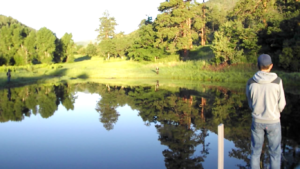 With many fish to be caught and much to be learned, the campers settled in to the barn that they would call home for the coming days. As the week progressed the campers gained experience in the worlds of conservation and fly fishing and made new connections with others who shared similar passions for the outdoors.
With many fish to be caught and much to be learned, the campers settled in to the barn that they would call home for the coming days. As the week progressed the campers gained experience in the worlds of conservation and fly fishing and made new connections with others who shared similar passions for the outdoors.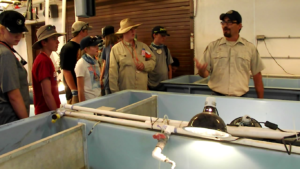 behind genetics, and were able to see what it takes to bring back a species from endangerment. Though the camp focuses on trout conservation, the hatchery harbors nothing but native species (meaning no trout), thus enabling campers to realize that conservation goes further than just the species most popular in Colorado rivers.
behind genetics, and were able to see what it takes to bring back a species from endangerment. Though the camp focuses on trout conservation, the hatchery harbors nothing but native species (meaning no trout), thus enabling campers to realize that conservation goes further than just the species most popular in Colorado rivers.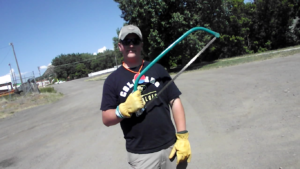 restoration project in collaboration with the Purgatoire River Anglers Chapter of CTU out of Trinidad. The Purgatoire River runs through Trinidad and has seen many restoration efforts in the past few years. Campers assisted in the removal of a fern called Russian olive- an invasive plant that consumes large amounts of water, taking it away from the river system. A day was spent using tools and chainsaws to cut down many of these large plants to better the fishery that the anglers of Trinidad value greatly.
restoration project in collaboration with the Purgatoire River Anglers Chapter of CTU out of Trinidad. The Purgatoire River runs through Trinidad and has seen many restoration efforts in the past few years. Campers assisted in the removal of a fern called Russian olive- an invasive plant that consumes large amounts of water, taking it away from the river system. A day was spent using tools and chainsaws to cut down many of these large plants to better the fishery that the anglers of Trinidad value greatly.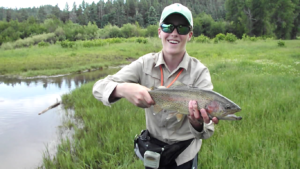 each day, and instruction from experienced guides and fishermen, campers enjoyed testing newly tied flies on eager fish. Astoundingly, at the end of five days, every young angler, regardless of skill level was able to successfully land a fish, with dozens of healthy trout seeing the net.
each day, and instruction from experienced guides and fishermen, campers enjoyed testing newly tied flies on eager fish. Astoundingly, at the end of five days, every young angler, regardless of skill level was able to successfully land a fish, with dozens of healthy trout seeing the net.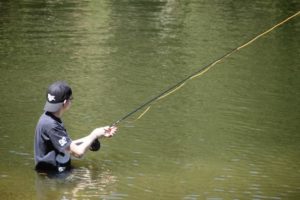 The first day began with a basic entomology class on bugs and their life cycles. Volunteers and camp leaders also showed the students what fish eat, and the flies that represent these species and phases. All of this was don in order to give students a better understanding of what the term “fly” fishing actually means.
The first day began with a basic entomology class on bugs and their life cycles. Volunteers and camp leaders also showed the students what fish eat, and the flies that represent these species and phases. All of this was don in order to give students a better understanding of what the term “fly” fishing actually means.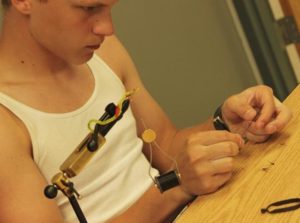
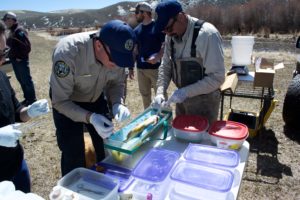 For this project, the chapter and partners purchased 15 RF tags that were surgically implanted into various fish in Tomichi Creek, a tributary of the Gunnison River. By attaching the RF tags to the fish in the creek, the chapter, CPW, and the partners involved could follow these trout and see what kind of movement they did and provide more information as to what causes fish to move.
For this project, the chapter and partners purchased 15 RF tags that were surgically implanted into various fish in Tomichi Creek, a tributary of the Gunnison River. By attaching the RF tags to the fish in the creek, the chapter, CPW, and the partners involved could follow these trout and see what kind of movement they did and provide more information as to what causes fish to move.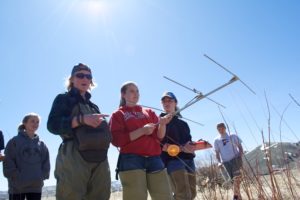 "We have had a few fish travel a pretty good distance. One fish in particular, which was tagged at the Lower Tagging Location, hung out in the same area we had released him in for several weeks. Then right around the same time the runoff started picking up he bolted upstream and was last detected near the confluence of Tomichi and Cochetopa Creeks. A run of over eight miles," said Wiles. "Now there is another tagged fish that has run nearly as far. This leads us to consider that the two missing fish may be farther up the Tomichi. This has effectively expanded our search area from a five mile stretch to who knows how big. Careful what you wish for."
"We have had a few fish travel a pretty good distance. One fish in particular, which was tagged at the Lower Tagging Location, hung out in the same area we had released him in for several weeks. Then right around the same time the runoff started picking up he bolted upstream and was last detected near the confluence of Tomichi and Cochetopa Creeks. A run of over eight miles," said Wiles. "Now there is another tagged fish that has run nearly as far. This leads us to consider that the two missing fish may be farther up the Tomichi. This has effectively expanded our search area from a five mile stretch to who knows how big. Careful what you wish for."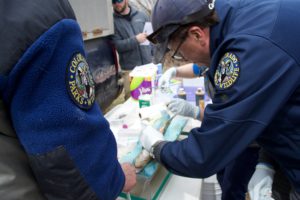 With help from a $2,500 grant from New Belgium Brewing, the chapter is expanding the project to include a website that will have a map of the Tomichi and points to where each fish is located.
With help from a $2,500 grant from New Belgium Brewing, the chapter is expanding the project to include a website that will have a map of the Tomichi and points to where each fish is located.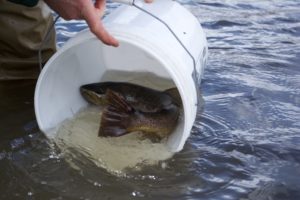 “I wanted to get the program going locally to help students develop more awareness and appreciation for our watershed and I thought the experience might generate some interest in resource management career paths,” said Jesse Kruthaupt, Upper Gunnison Project Specialist for TU. “In addition to those benefits, understanding trout behaviors in this area will be a very useful discussion making and monitoring tool for future restoration work. TU couldn’t have done this alone, Colorado Parks and Wildlife and the Upper Gunnison River Water Conservancy District deserve a big ‘Thank You’ for helping to make this happen.”
“I wanted to get the program going locally to help students develop more awareness and appreciation for our watershed and I thought the experience might generate some interest in resource management career paths,” said Jesse Kruthaupt, Upper Gunnison Project Specialist for TU. “In addition to those benefits, understanding trout behaviors in this area will be a very useful discussion making and monitoring tool for future restoration work. TU couldn’t have done this alone, Colorado Parks and Wildlife and the Upper Gunnison River Water Conservancy District deserve a big ‘Thank You’ for helping to make this happen.”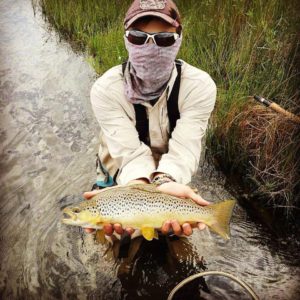
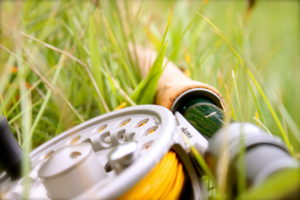
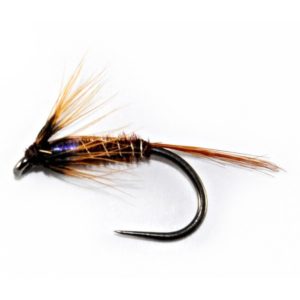
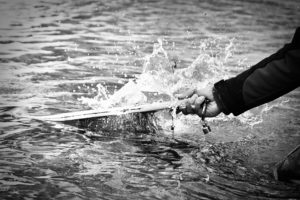 Thus it is best to keep a fish in the water as much as possible, with a photo being taken swiftly- holding the fish only a few inches above the water.
Thus it is best to keep a fish in the water as much as possible, with a photo being taken swiftly- holding the fish only a few inches above the water.